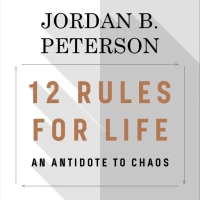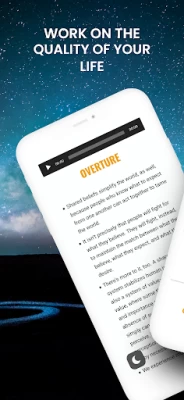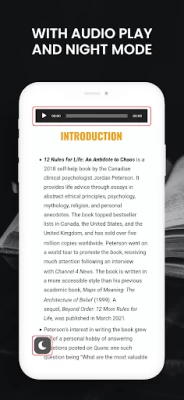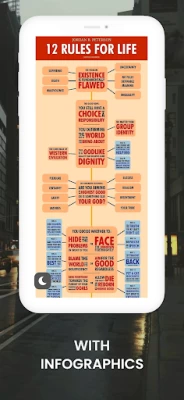

12 Rules for Life - Summary
3 by NerdyPanda (0 Reviews) October 01, 2024Latest Version
Version
3
3
Update
October 01, 2024
October 01, 2024
Developer
NerdyPanda
NerdyPanda
Categories
Education
Education
Platforms
Android
Android
Downloads
0
0
License
Free
Free
Package Name
com.harrynagalia.TRL
com.harrynagalia.TRL
Report
Report a Problem
Report a Problem
More About 12 Rules for Life - Summary
12 Rules for Life: An Antidote to Chaos is a 2018 self-help book by the Canadian clinical psychologist Jordan Peterson. It provides life advice through essays in abstract ethical principles, psychology, mythology, religion, and personal anecdotes. The book topped bestseller lists in Canada, the United States, and the United Kingdom, and has sold over five million copies worldwide. Peterson went on a world tour to promote the book, receiving much attention following an interview with Channel 4 News. The book is written in a more accessible style than his previous academic book, Maps of Meaning: The Architecture of Belief (1999). A sequel, Beyond Order: 12 More Rules for Life, was published in March 2021.
The book is divided into chapters with each title representing one of the following twelve specific rules for life as explained through an essay.
"Stand up straight with your shoulders back."
"Treat yourself like you are someone you are responsible for helping."
"Make friends with people who want the best for you."
"Compare yourself to who you were yesterday, not to who someone else is today."
"Do not let your children do anything that makes you dislike them."
"Set your house in perfect order before you criticize the world."
"Pursue what is meaningful (not what is expedient)."
"Tell the truth – or, at least, don't lie."
"Assume that the person you are listening to might know something you don't."
"Be precise in your speech."
"Do not bother children when they are skateboarding."
"Pet a cat when you encounter one on the street."
The book's central idea is that "suffering is built into the structure of being" and although it can be unbearable, people have a choice either to withdraw, which is a "suicidal gesture", or to face and transcend it. Living in a world of chaos and order, everyone has "darkness" that can "turn them into the monsters they're capable of being" to satisfy their dark impulses in the right situations. Scientific experiments like the Invisible Gorilla Test show that perception is adjusted to aims, and it is better to seek meaning rather than happiness. Peterson notes:
It's all very well to think the meaning of life is happiness, but what happens when you're unhappy? Happiness is a great side effect. When it comes, accept it gratefully. But it's fleeting and unpredictable. It's not something to aim at – because it's not an aim. And if happiness is the purpose of life, what happens when you're unhappy? Then you're a failure.
The book advances the idea that people are born with an instinct for ethics and meaning, and should take responsibility to search for meaning above their own interests (Rule 7, "Pursue what is meaningful, not what is expedient"). Such thinking is reflected both in contemporary stories such as Pinocchio, The Lion King, and Harry Potter, and in ancient stories from the Bible. To "Stand up straight with your shoulders back" (Rule 1) is to "accept the terrible responsibility of life," to make self-sacrifice, because the individual must rise above victimization and "conduct his or her life in a manner that requires the rejection of immediate gratification, of natural and perverse desires alike. "The comparison to neurological structures and behavior of lobsters is used as a natural example to the formation of social hierarchies.
"Stand up straight with your shoulders back."
"Treat yourself like you are someone you are responsible for helping."
"Make friends with people who want the best for you."
"Compare yourself to who you were yesterday, not to who someone else is today."
"Do not let your children do anything that makes you dislike them."
"Set your house in perfect order before you criticize the world."
"Pursue what is meaningful (not what is expedient)."
"Tell the truth – or, at least, don't lie."
"Assume that the person you are listening to might know something you don't."
"Be precise in your speech."
"Do not bother children when they are skateboarding."
"Pet a cat when you encounter one on the street."
The book's central idea is that "suffering is built into the structure of being" and although it can be unbearable, people have a choice either to withdraw, which is a "suicidal gesture", or to face and transcend it. Living in a world of chaos and order, everyone has "darkness" that can "turn them into the monsters they're capable of being" to satisfy their dark impulses in the right situations. Scientific experiments like the Invisible Gorilla Test show that perception is adjusted to aims, and it is better to seek meaning rather than happiness. Peterson notes:
It's all very well to think the meaning of life is happiness, but what happens when you're unhappy? Happiness is a great side effect. When it comes, accept it gratefully. But it's fleeting and unpredictable. It's not something to aim at – because it's not an aim. And if happiness is the purpose of life, what happens when you're unhappy? Then you're a failure.
The book advances the idea that people are born with an instinct for ethics and meaning, and should take responsibility to search for meaning above their own interests (Rule 7, "Pursue what is meaningful, not what is expedient"). Such thinking is reflected both in contemporary stories such as Pinocchio, The Lion King, and Harry Potter, and in ancient stories from the Bible. To "Stand up straight with your shoulders back" (Rule 1) is to "accept the terrible responsibility of life," to make self-sacrifice, because the individual must rise above victimization and "conduct his or her life in a manner that requires the rejection of immediate gratification, of natural and perverse desires alike. "The comparison to neurological structures and behavior of lobsters is used as a natural example to the formation of social hierarchies.
Rate the App
Add Comment & Review
User Reviews
Based on 0 reviews
No reviews added yet.
Comments will not be approved to be posted if they are SPAM, abusive, off-topic, use profanity, contain a personal attack, or promote hate of any kind.










































